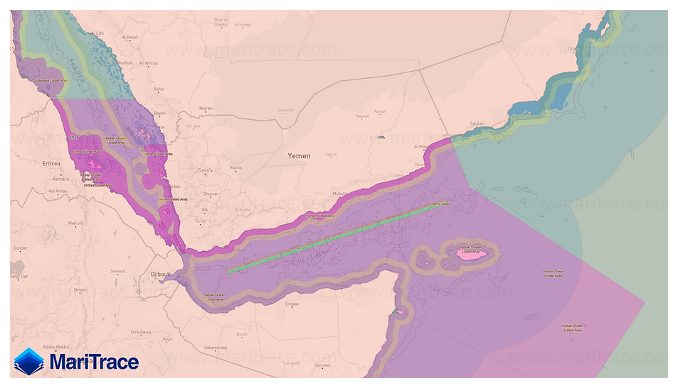
Risk of collateral damage for yachts in southern Red Sea
Attacks on merchant shipping in the Gulf of Aden and Red Sea are continuing. The tragic loss of three crew aboard the container ship True Confidence, struck by an anti-ship ballistic missile on 6 March, underscores how very little protection is afforded to seafarers in the front line, writes Thomas Owen, CEO of MariTrace. While the attacks may be intended to mark out ships with business connections to the US and the UK, the risks of collateral damage and the very real threat to the lives of innocent people are clear.
As with routing decisions in any part of the world, any decision to transit a high-risk area remains with the yacht owner. A yacht master deciding to take the Gulf of Aden route to the Red Sea does so at their own risk. Security is a very subjective term: in maritime as in many other domains, the threshold at which people feel secure varies enormously depending on context, culture, experience, operating conditions and so on. Many of the crew who accompany these voyages have deep experience and expertise for making risk and threat assessment and this experiential knowledge is immensely valuable to the industry as everyone adapts to the new maritime security challenges.
Monitoring yacht traffic in danger zone
Close monitoring of all vessel traffic through the Red Sea and Gulf of Aden has been ongoing since attacks on commercial shipping began last November.

MariTrace has observed sailing vessels and yachts among the merchant shipping that transits the high-risk area (pictured left). When they do transit, it tends to be in small groups of two or three and are typically 18-25 metres. Three such groupings have been observed since mid January.
An October 2022 update from World Sailing International Regulations Commission alongside Maritime Security Centre Horn of Africa (MSCHOA) intimated that the increase in deployed private armed security contractors on merchant vessels was thought to increase the threat to smaller yachts, who may have been seen as easier targets.
Eighteen months on, much of what is contained in the guidelines remains relevant for mitigating piracy, however, the attack patterns that were previously described have evolved completely. Where once the main threat was from armed persons onboard skiffs, today’s threats are very different.
Drones and inbound missile attacks
Onboard security teams and counter-piracy measures are of little effect against drones and inbound missiles.
The US and Europe have mounted maritime task forces to secure the freedom of navigation for commercial ships. These missions are designed to safeguard global trade routes. Yachts and private sailing vessels are not explicitly included in their remit.
In February 2024, as it became clear the crisis is likely to continue, industry associations updated their guidelines for merchant shipping transiting the Red Sea and Gulf of Aden.
In the current warnings in place for private vessels, United Kingdom Maritime Trade Operations (UKMTO) advises: “Leisure craft should make early contact in advance with the naval/military authorities to determine if the VRA area is safe to transit; regional activity has indicated attacks occur on both large and small vessels. Transit close to areas of conflict should be avoided. Close contact should be maintained with UKMTO throughout any voyage.”
MSCHOA confirmed to MariTrace that the regional coordination centre continues to advise: “In view of the recent escalation in pirate attacks in the area of the Southern Red Sea, Gulf of Aden and Indian Ocean, and the consequent very high risk, the essential advice is not to enter this area.”
In a previous statement (May 2020), MSCHOA and the World Sailing International Regulations Commission released a warning notice which remains relevant today. “The danger of piracy and consequent loss of life and property in the GoA (Gulf of Aden), Yemeni and Somali waters (up to 750 miles offshore), is high. Yachts are strongly recommended to avoid the area.”
At that time, yachts were urged (but not mandated) to register with UKMTO and MSCHOA at least fourteen days prior to entering into the High Risk Area (HRA). And now private vessels are advised to inform MSCHOA by email.
In maritime security as in many other domains, reporting information by itself is not ‘safety’: rather, it is the ability and know-how to incorporate reporting with a whole range of actions that can generate assurances. Informing the authorities inline with best management practices is just one task among the many responsibilities that master and crew have in safely navigating these areas.
Owners of private yachts may wish to consider advanced tracking solutions that enable vessel position monitoring and risk planning even when AIS is switched off – if their voyage is essential – allowing them to maintain close contact.
The services that MariTrace offers are designed to enable and inform decision making at sea and onshore. MariTrace can help with voyage risk planning (i.e. know before you go), threat mitigation (know about and avoid threats that arise during transit) and learning (understand the pattern of life in, say, a busy port area or chokepoint). The company offers a layered approach to security and risk mitigation: by combining the rich insights available through MariTrace (continually updated vessel movements, weather data, piracy and other threats, conflict areas and so on) with its latest innovation: Mercury. Owners and operators can attain a near realtime picture of the traffic and evolving risks in the area and their position within that area.
Main image shows seven sailing vessels transiting the Southern Red Sea on 11 March 2024, within hours of further incidents reported by UKMTO. Source: MariTrace.
The post Risk of collateral damage for yachts in southern Red Sea appeared first on Marine Industry News.
